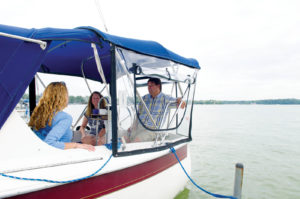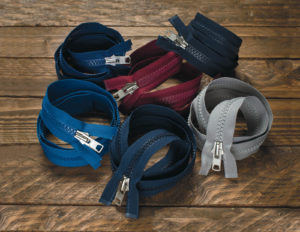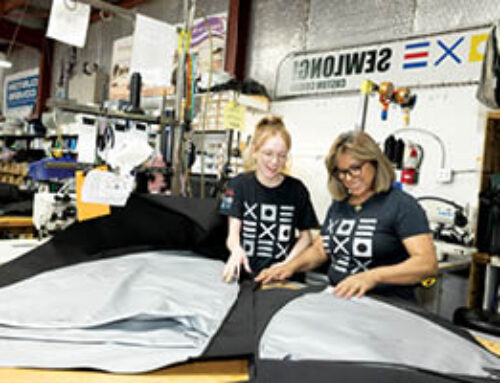Zipper tricks and techniques

Choosing the right type of zipper for a project comes down to the application, desired longevity and environmental conditions.
Advanced tips and techniques for choosing and working with zippers in your projects.
Providing an excellent end product is paramount to marine fabricators, and zippers play a vital role in the long-term functionality of everything from covers to cushions. But zippers can be tricky. Choosing the right one can be confusing, and working with zippers in difficult situations takes both patience and expertise. This article is filled with excellent advice as well as some trade secrets about working with zippers in your projects.
Features that matter
For Rebecca Tarockoff, head seamstress at Chicago Marine Canvas, choosing a zipper comes down to the type of project she is working on. “Coil zippers are great to use on roll-up windows because they are more flexible than plastic molded zippers so they lie more flat on major curves,” Tarockoff says. “We use Lenzip’s coil chain zippers because they are highly water resistant. The outside part of the zipper, which is exposed to the elements, is coated in polyurethane. This creates a water barrier, helping prevent water leakage if it rains or if you’re out on the water on a rough day.”
Chicago Marine Canvas also uses plastic molded zippers. “We use them on projects that have mostly straight or slightly curved lines, like on biminis and full enclosure panels,” says Tarockoff. “I find that Lenzip’s plastic molded zippers are stronger than a coil zipper because they lock in place, which is what you want when you have your bimini or full enclosure up on your boat.”
There are, of course, pros and cons to any zipper choice. Plastic molded zippers are impossible to repair if a tooth breaks off, while metal zippers are repairable. However, plastic zippers are popular among marine fabricators because they last longer, are easier to work with and don’t rust after being exposed to the elements over time.

: AquaGuard®/Vislon® zippers from YKK® are perfect for outdoor applications requiring moisture protection or an airtight seal. This practically waterproof zipper offers great strength and smooth operation. The polyurethane coating (shiny outer surface) increases water repellency but reduces the flexibility of this coil zipper so it is best used on projects without curves. Photo: Sailrite.
“Plastic zippers are best for saltwater exposure,” says Terry McCullough, senior product engineer at YKK®, the world’s largest zipper manufacturer. “Metal zippers, while made from brass, will oxidize over time and can become difficult to operate.”
McCullough says that larger tooth plastic zippers have had very good results in the marine market. The larger tooth option resists collecting dirt and grime compared to a smaller tooth zipper, either coil or plastic.
YKK also provides a water-resistant finish on zippers to help prevent dirt and mold buildup on the zipper tape. And for the plastic tooth zippers, YKK offers UV-resistant materials and powder-coated sliders for a more saltwater-resistant, highly durable slider—the perfect choice for outdoor applications. The powder-coated slider offers a wider range of colors over the plastic slider, which is only available in black.
Longevity is key
Manart-Hirsch Co. Inc. in Lynbrook, N.Y., has been a distributor of YKK brand zippers for more than 40 years. Richard Hirsch, president of Manart-Hirsch, says the most popular zipper within the marine industry is the #10 Vislon®. Made out of a UV-resistant acetal tooth with a water-repellent polyester tape, this zipper has an extremely long field life and tends to open and close easily throughout the life of the canvas products into which it is sewn. YKK’s Marine Mates® zippers are a unique line of Vislon zippers created specifically to resist corrosion and offer protection from the sun’s damaging UV rays.
YKK’s Ziplon zipper, most commonly known as a coil zipper, which gets its name from its rounded tooth construction, is another favorite among marine fabricators. It has a polyester tape with a monofilament coil containing a nylon cord. “This gives the Ziplon zipper extreme crosswise strength,” Hirsch says.

The LENZIP No. 12 Marine Grade UV Zipper is larger than the industry standard with a generous 1-inch wide tape for easier sewing. Durable DuPont Delrin® UV resins make up the teeth and complement the UV stable tape. Photo: Lenzip.
Because of its strength and flexibility on curves, and due to its rounded teeth, Ziplon is extremely popular on enclosure panels. And while both Vislon and Ziplon zippers are available on a continuous roll or cut size separating zippers, the slides for both zippers are available in a multitude of styles, including single tab, double tab, locking, non-locking, short tab, long tab, metal and nylon.
For zippers used on enclosures, Hirsch also has seen increased interest in YKK’s AquaGuard® Ziplon continuous zipper.
“AquaGuard has a polyurethane coating on the backside of the zipper tape to prevent any leaking from areas that are consistently getting wet,” Hirsch says. Standard Ziplon sliders can be used with AquaGuard zipper tape.
Metal versus plastic
As a marine zipper distributor, Matt Grant, vice president at Sailrite Enterprises Inc. in Columbia City, Ind., rarely recommends marine fabricators use metal zippers. He says metal simply doesn’t last long in saltwater spray because it corrodes over time, which impedes the slider from moving freely on the zipper. And, as expected, a metal zipper with a metal slider can lead to a completely seized zipper slider.
“What we see as common is plastic zipper teeth with either Delrin® (plastic) sliders or metal sliders,” Grant says. Sailrite has opted to standardize the Delrin slider in most cases, as it finds these last the longest and are suitably strong for almost all marine uses. “Other distributors and fabricators might argue that metal sliders move more freely on the plastic zipper chain and they are correct, at least initially,” Grant says. “But once any corrosion starts, this advantage is lost.”
However, many fabricators have found that for applications requiring the zipper to make a tight turn, coil zippers are often better than plastic tooth zippers because the smaller coil teeth will turn corners more easily. But there are disadvantages with coil, with the main issue being abrasions to the sewing thread holding the coil to the tape, causing the zipper to potentially fail.

Sailrite recommends coil zippers for curved or “smile” zippers like this one in an enclosure panel. Photo: Sailrite.
At Cover Girl Marine Canvas & Upholstery in Buford, Ga., owner Tammy Hampton and her team use both plastic and coil zippers, and they are always on the lookout for new and innovative products to help them in their job.
One key area of focus for Cover Girl Marine is the longevity of a zipper. As such, Hampton has found that coil zippers will outlast Vislon and are very useful for taking a radius, such as a “smile” zipper or other radius application.
“The slider [on a coil zipper] tends to slide easier around the radius without catching on the teeth,” Hampton says. “We prefer metal sliders and use them in the shop. Plastic sliders are a weaker product, but the fact is most boaters don’t swap zipper sliders as part of their yearly maintenance, so in salt water the plastic is the way to go.”
Indeed, as Grant explains, Sailrite offers both coil and Vislon zippers since there are certain applications where one or the other works better. Coil zippers bend curves, like “smiles” or “frowns,” better since the relatively soft “coils” of sewn zipper teeth are more flexible than the more rigid Vislon design, where the teeth are molded onto the zipper tape. But the sewn teeth of the coil design likewise can become the weak point with sun exposure.
“Consequently, it is desirable to use Vislon zippers for marine applications in all areas except those requiring a curved zipper in a panel that must be as flat and smooth as possible when the zipper is closed,” Grant says. “If a coil zipper is to be used, it is recommended to protect the sewn coils from the sun with a fabric flap. But as you might expect, this can be challenging along a curve.”
While Grant suggests the use of Delrin sliders in most cases, there is an exception to this: namely, the new YKK finished zippers in colors. In an effort to offer several colors without having to mold huge quantities of custom-colored Delrin sliders, Sailrite has opted to use the silver zinc alloy with nickel plating on every color other than white and black.
No matter which type of project a fabricator is working on, carrying well-branded zipper products—from zipper components to repair products—goes a long way to ensuring quality and consistency. “Most fabricators understand that putting a few extra dollars in quality zippers, thread and fasteners is important,” Grant says.
“It can mean fewer headaches down the road.”
Maura Keller is a freelance writer from Plymouth, Minn.
 TEXTILES.ORG
TEXTILES.ORG 







